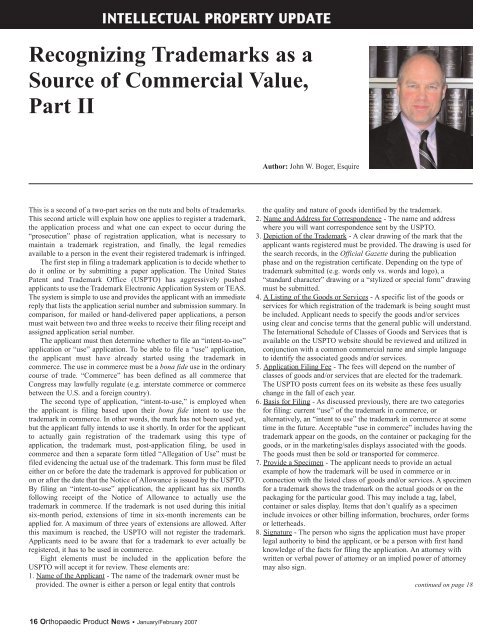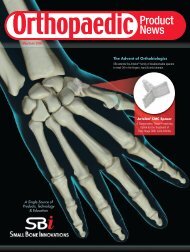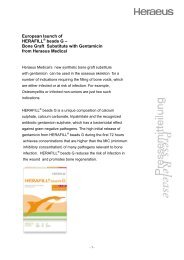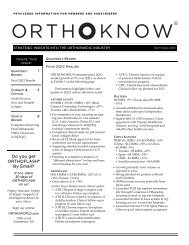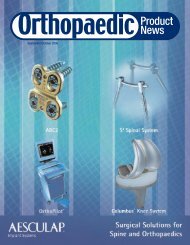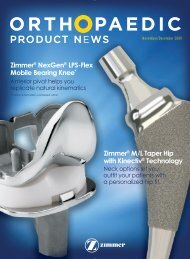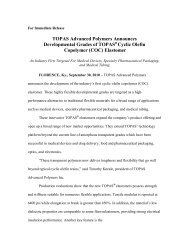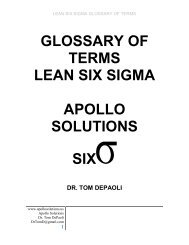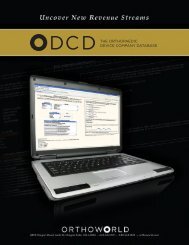AAOS, Arthroscopy - Orthoworld
AAOS, Arthroscopy - Orthoworld
AAOS, Arthroscopy - Orthoworld
Create successful ePaper yourself
Turn your PDF publications into a flip-book with our unique Google optimized e-Paper software.
INTELLECTUAL PROPERTY UPDATERecognizing Trademarks as aSource of Commercial Value,Part IIAuthor: John W. Boger, EsquireThis is a second of a two-part series on the nuts and bolts of trademarks.This second article will explain how one applies to register a trademark,the application process and what one can expect to occur during the“prosecution” phase of registration application, what is necessary tomaintain a trademark registration, and finally, the legal remediesavailable to a person in the event their registered trademark is infringed.The first step in filing a trademark application is to decide whether todo it online or by submitting a paper application. The United StatesPatent and Trademark Office (USPTO) has aggressively pushedapplicants to use the Trademark Electronic Application System or TEAS.The system is simple to use and provides the applicant with an immediatereply that lists the application serial number and submission summary. Incomparison, for mailed or hand-delivered paper applications, a personmust wait between two and three weeks to receive their filing receipt andassigned application serial number.The applicant must then determine whether to file an “intent-to-use”application or “use” application. To be able to file a “use” application,the applicant must have already started using the trademark incommerce. The use in commerce must be a bona fide use in the ordinarycourse of trade. “Commerce” has been defined as all commerce thatCongress may lawfully regulate (e.g. interstate commerce or commercebetween the U.S. and a foreign country).The second type of application, “intent-to-use,” is employed whenthe applicant is filing based upon their bona fide intent to use thetrademark in commerce. In other words, the mark has not been used yet,but the applicant fully intends to use it shortly. In order for the applicantto actually gain registration of the trademark using this type ofapplication, the trademark must, post-application filing, be used incommerce and then a separate form titled “Allegation of Use” must befiled evidencing the actual use of the trademark. This form must be filedeither on or before the date the trademark is approved for publication oron or after the date that the Notice of Allowance is issued by the USPTO.By filing an “intent-to-use” application, the applicant has six monthsfollowing receipt of the Notice of Allowance to actually use thetrademark in commerce. If the trademark is not used during this initialsix-month period, extensions of time in six-month increments can beapplied for. A maximum of three years of extensions are allowed. Afterthis maximum is reached, the USPTO will not register the trademark.Applicants need to be aware that for a trademark to ever actually beregistered, it has to be used in commerce.Eight elements must be included in the application before theUSPTO will accept it for review. These elements are:1. Name of the Applicant - The name of the trademark owner must beprovided. The owner is either a person or legal entity that controlsthe quality and nature of goods identified by the trademark.2. Name and Address for Correspondence - The name and addresswhere you will want correspondence sent by the USPTO.3. Depiction of the Trademark - A clear drawing of the mark that theapplicant wants registered must be provided. The drawing is used forthe search records, in the Official Gazette during the publicationphase and on the registration certificate. Depending on the type oftrademark submitted (e.g. words only vs. words and logo), a“standard character” drawing or a “stylized or special form” drawingmust be submitted.4. A Listing of the Goods or Services - A specific list of the goods orservices for which registration of the trademark is being sought mustbe included. Applicant needs to specify the goods and/or servicesusing clear and concise terms that the general public will understand.The International Schedule of Classes of Goods and Services that isavailable on the USPTO website should be reviewed and utilized inconjunction with a common commercial name and simple languageto identify the associated goods and/or services.5. Application Filing Fee - The fees will depend on the number ofclasses of goods and/or services that are elected for the trademark.The USPTO posts current fees on its website as these fees usuallychange in the fall of each year.6. Basis for Filing - As discussed previously, there are two categoriesfor filing: current “use” of the trademark in commerce, oralternatively, an “intent to use” the trademark in commerce at sometime in the future. Acceptable “use in commerce” includes having thetrademark appear on the goods, on the container or packaging for thegoods, or in the marketing/sales displays associated with the goods.The goods must then be sold or transported for commerce.7. Provide a Specimen - The applicant needs to provide an actualexample of how the trademark will be used in commerce or inconnection with the listed class of goods and/or services. A specimenfor a trademark shows the trademark on the actual goods or on thepackaging for the particular good. This may include a tag, label,container or sales display. Items that don’t qualify as a specimeninclude invoices or other billing information, brochures, order formsor letterheads.8. Signature - The person who signs the application must have properlegal authority to bind the applicant, or be a person with first handknowledge of the facts for filing the application. An attorney withwritten or verbal power of attorney or an implied power of attorneymay also sign.continued on page 1816 Orthopaedic Product News • January/February 2007


